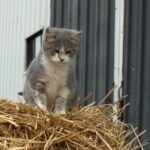Badges are mammals that are medium to small in size and completely covered with coarse fur. They rely on an excellent sense of smell to avoid danger and locate food. Badgers are considered omnivores although the majority of their diet typically includes small amphibians, mammals, reptiles and insects. All types of Badgers are equipped with long, sharp teeth and claws which are used to dig shelter, find food and as defense from predators. Badgers also excrete an extremely foul odor from their anal glands that in some cases can cause immobilization.
American Badger
Location:
North America
Description:
The American Badger is grey or brown in color. The face has darker colored or black areas that are broken with white stripes. The largest white stripe runs along the center of the head from the base of the nose to the top of the neck.
Diet:
They hunt for food by digging through the soil eating amphibians, arachnids, small mammals, insects and insect larva.
Active:
The American Badge will become active during the day or night, but around humans they remain nocturnal.
Burmese Ferret-Badger
Location:
Southern portion of Asia
Description:
The Burmese Ferret-Badger is a dark shade of white, grey or brown. The head, chin, neck and front of the chest is white with dark colored or black lines.
Diet:
A Burmese Ferret-Badger eats a wide variety of food by foraging along the ground and climbing through the trees eating dead animals, small mammals, birds and their eggs, amphibians, insects, worms, fruit and plant roots.
Active:
A Burmese Ferret-Badger is active during the night.
Chinese Ferret-Badger
Location:
Asia
Description:
The primary body color of a Chinese Ferret-Badger is various shades of grey or brown. The neck and spots on the face and head are shades of white to light yellow or orange with a white stripe along the top of the body.
Diet:
A Chinese Ferret-Badger eats a wide variety of food including dead animals, small mammals, birds and their eggs, amphibians, insects, worms, fruit and plant roots.
Active:
A Chinese Ferret-Badger is active during the night.
Eurasian Badger
Location:
Asia, Britain, Europe, Ireland and Japan
Description:
The Eurasian Badger has a white throat and black and white striped face, typically the black portions stretch the length of the head starting at the nose and running over the eyes and stopping at the ears. The fur on the legs and under portions of the body is black and the upper portion is grey or brown.
Diet:
The Eurasian Badger scavenges along the ground and digs through the dirt for their main food source of earthworms, but they also eat small mammals, insects, insect larva, dead animals, fruit, nuts and plant roots.
Active:
The Eurasian Badger is active during the night.
Everett‘s Ferret-Badger
Location:
Indonesia (Northern part of Borneo)
Description:
The Everett’s Ferret-Badger is a grey or dark grey color with a white chin, white spots on the face and head and a white stripe along the top of the body.
Diet
An Everett’s Ferret-Badger eats a wide variety of food including dead animals, small mammals, birds and their eggs, amphibians, insects, worms, fruit and plant roots.
Active
The Everett’s Ferret-Badger is active during the night.
Honey Badger
Location:
Africa, Arabia, India and Middle East
Description:
The Honey Badger has black fur on the lower half of the body including the face and legs. The top portion is white and grey.
Diet:
The Honey Badger is best known for attaching bee hives in search of brood which is the bee’s larva stage. They also eat rodents, birds, small reptiles, fruits, berries and plant roots.
Active:
A Honey Badger will remain active during the day or night, bit around humans they are nocturnal.
Javan Ferret-Badger
Location:
Indonesia (island of Java)
Description:
The Javan Ferret-Badger is a dark grey or brown color with a long thin short body and short thin legs.
Diet
The Javan Ferret-Badger eats a wide variety of food including dead animals, small mammals, birds and their eggs, amphibians, insects, worms, fruit and plant roots.
Active
The Javan Ferret-Badger is active during the night.
References
Animal Planet
Honey Badger
Steve Jackson’s Badger Pages
Wildlife Britain




